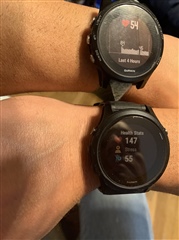I am seeing same issue. I'm posting a picture showing a Garmin 935 on one wrist, and a Garmin 945 on another wrist (excuse the makeshift armband, I can assure you the "tightness" is same on both). So, this is same person, skintone and setting...just a different 1 generation older Garmin model watch using OHR. They are showing wildly different readings: 54 BPS (on 935, top) vs 147 BPS (on 945, bottom).
Because the 945 OHR appears inaccurate it is compounding issues with the 945 that have changed and were supposed to be FEATUREs and a reason to buy it in the first place (I may not have all the Garmin marketing terminology correct here):
New Feature 1 - Exercise Load: The new watch (and perhaps Garmin in general) seems to have shifted to using "Exercise Load" -- versus the old way of using Training Stress Score (TSS). Since Exercise Load is based on EPOC and therefore, an extrapolation of Heart Rate using software modelling, none of that load for a given workout is accurate. IMHO: If you are going to switch to this EPOC methodology, you have to be very very sure the HR is accurate or be able to have a user setting to go back to TSS.
New Feature 2 - Fitness Training Progression: Using EPOC from New Feature #1 cannot be showing fitness recovery vs fitness progression over time because EPOC is not accurate to begin with. For example: The watch keeps claiming I'm doing "High Aerobic" workouts when in fact, I know I'm doing only a "Low Aerobic" workout (like a Recovery Spin). I've been fighting with this watch for weeks trying to understand how I could not be in recovery by this point!! Looks like I will ignore and use Training Peaks TSS ....
New Feature 3 - Abnormal Heart Rate Alarms: I had an "Abnormal Heart Rate" alarm go off yesterday just watching a football game (well over 100, just sitting there, nothing exciting going on). I was so alarmed I almost made a Heart Doctors appointment today until I found this thread!
Old Feature - Heart Rate Zones (useless): I recently completed a Triathlon and used the watch for Run Pacing and wanted to stay in Zone 2 as it was long course. However, it kept telling me I was at or above Threshold (Zone 3->Zone 4). I couldn't figure out why it was running so "High" as I did not feel I was exerting myself -- and forced myself to Walk many of the segments to stay in Zone 2 and be able to finish the race. Therefore, it impacted my race time!!!! Admittedly about 3/4 through the race I started to "just race by feel" and ignored the watch... but the watch is supposed to guide here. Further, psychologically, I was really getting down in the race thinking "What Am I doing wrong" ... "Am I drinking enough and getting dehydrated and that is why heart rate is so high", "is it heat related", etc.....
Don't get me wrong: I've been an avid fan of Garmin triathlon watches for many many years and have also owned since the Garmin Forerunner 910XT and always upgrade - I've never had any issues like this. However, at this point, I'm thinking of going back to the 935 which I'm glad I had not time to sell yet.
Can anyone from Garmin help here? The watch is clearly defective and should be fixed immediately either through software update or replacing these altogether.



